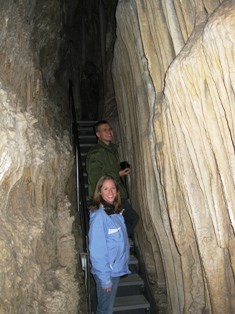
NPS PHOTO maci macpherson The Wonder, Power, and Mystery of CavesCaves have excited and attracted people since the beginning of time. For some, the draw was a belief in the supernatural. Caves figured into the religions of many ancient cultures. The Greeks went to caves for oracles. Many Olmec sculptures depict a priest coming out of an underground void. The Lakota believe that a cave in the Black Hills may be the place of creation. Today, cavers are still drawn to the mystery. The thrill of exploration, the curiosity of the unknown, and the desire to answer the question, "where does that hole go?" continues to push cavers to explore these underground worlds. Scientists look to caves for their geologic secrets, unique forms of life, and for reserves of information about natural history. For over a hundred years, people have been going deep into Lehman Caves drawn by their curiosity, and leave in wonder of its secret mysteries.Just what is a cave? A cave is a naturally occurring underground cavity. There are many different types of caves, including solution caves, tectonic caves, boulder caves, sea caves, and lava tubes. Tectonic caves tend to be relatively small and can form in almost any type of rock that has been highly fractured. Lava tubes are the fastest forming type of cave. They form as a flow of lava is running down an inclined surface. The surface of the lava flow cools from contact with the air, and hardens to rock, while the inside keeps flowing. When the inside drains out, the result is a black tube of rock. Some caves may have ice in them seasonally, or year round. Depending on the shape of a cave and its entrance, caves can trap cold air and contain permanent ice. Lava tubes can often be cold air traps. Solution caves, such as Lehman Caves, can have a great variety of formations and passage patterns. Lehman Caves as a Geologic PuzzleLehman Caves present an interesting geologic puzzle. The geologists believe that they have figured out many of the mysteries of the cave, but there are many more unanswered questions. There is a bacteria in the cave that could be studied, along with potential bacterial causes of moonmilk, colorations, and condensation corrosion. A paleontological dig could turn up some very interesting results and could help determine if and when there might have been another entrance to the cave. The Gypsum Annex is an interesting part of the cave because it is so incredibly different from the main cave. Why? It might be possible to learn more about past climatic conditions by studying the speleothems. Many opportunties for discovery and learning still exist in Lehman Caves. The mysteries continue, and the answers to these questions will only lead us to more questions. |
Last updated: April 22, 2021
